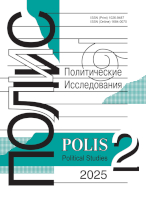Network vs Message in Protest Diffusion on Social Media:
Theoretical and Data Analytics Perspectives
Akhremenko A.S.,
Professor of the School of Social Sciences, National Research University Higher School of Economics, aakhremenko@hse.ru
elibrary_id: 124097 | ORCID: 0000-0001-8002-7307 | RESEARCHER_ID: L-3000-2015
Stukal D.K.,
Lecturer in data analytics, School of Social and Political Sciences, University of Sydney, denis.stukal@gmail.com
elibrary_id: 1096522 | ORCID: 0000-0001-6240-5714 | RESEARCHER_ID: ABA-3314-2020
Petrov A.P.,
Senior Researcher, Keldysh Institute for Applied Mathematics (Russian Academy of Sciences), petrov.alexander.p@yandex.ru
elibrary_id: 15671 | ORCID: 0000-0001-5244-8286 | RESEARCHER_ID: R-6729-2016
DOI: 10.17976/jpps/2020.02.06
Akhremenko A.S., Stukal D.K., Petrov A.P. Network vs Message in Protest Diffusion on Social Media: Theoretical and Data Analytics Perspectives. – Polis. Political Studies. 2020. No. 2. https://doi.org/10.17976/jpps/2020.02.06
The study was supported by the RFBR and ANO EISI, project 19-011-31341, “Social networks as an instrument of political mobilization: analysis of communications and assessment of potential”.
Social media can act as an environment that accumulates and concentrates protest sentiment before it brings people to the streets. The social ties that connect people online are similar to their offline ties, and the structure of social ties can affect the diffusion of both the protest-related information and the protest itself. In addition, social media can serve as core platforms or environments for articulating collective goals and identities. This article builds on previous scholarship that has developed these ideas, and extends it with an empirical analysis of the Venezuelan Twittersphere during the political unrest in that country. Short messages – tweets – are the basic building blocks of online protest behavior on Twitter. Some of these tweets get virally retweeted so can achieve very broad audiences. These viral tweets are arguably of key importance for the articulation of protest sentiment. However, what kind of tweet tends to become viral? Is it a tweet posted by someone with a fortunate position in the social media network, or one that stands out as particularly catchy or emotional? We formalize and test these competing hypotheses using two groups of empirically observable features characterizing either the author of a tweet or its content. The first group of features includes the average number of followers the retweeting users have, the total number of followers the author of the original tweet has, whether the author or a retweeter are verified Twitter users, etc. The other group describes the content of the tweet and includes binary indicators of whether the tweet contains links to external platforms, emojis, or question or exclamation marks. The dependent variable is the total number of retweets. We analyze over 5.7 million unique tweets using modern data science approaches and methods (e.g. a LASSO-regression model, cross-validation, etc.) and find that the first-group features are much more informative for modeling the dependent variable. This finding turns out to be very robust and holds for both OLS and LASSO models. In addition, given the increasing importance that social media bots – i.e. automated accounts that are able to post retweet, among other things – have recently gained for political communication, we also perform robustness checks by removing bots from the analysis. We find that the network characteristics matter more than the content-related features under study.
References
Akhremenko A., Yureskul E., Petrov A. 2019. Latent Factors of Protest Participation: A Basic Computational Model. – 2019 Twelfth International Conference “Management of Large-Scale System Development: (MLSD). Moscow: IEEE. https://doi.org/10.1109/MLSD.2019.8910999
Barbera P., Wang N., Bonneau R., Jost J.T., Nagler J., Tucker J., Gonzalez-Bailon S. 2015. The Critical Periphery in the Growth of Social Protests. – PloS ONE. 10(11): e0143611. https://doi.org/10.1371/journal.pone.0143611
Bastos M.T., Mercea D., Charpentier A. 2015. Tents, Tweets, and Events: The Interplay Between Ongoing Protests and Social Media. – Journal of Communication. Vol. 65. No. 2. P. 320-350. https://doi.org/10.1111/jcom.12145
Bisbee J., Larson J.M. 2017. Testing Social Science Network Theories with Online Network Data: An Evaluation of External Validity. – American Political Science Review. Vol. 111. No. 3, P. 502-521. https://doi.org/10.1017/s0003055417000120
Centola D. 2010. The Spread of Behavior in an Online Social Network Experiment. – Science. Vol. 329. No. 5996. P. 1194-1197. https://doi.org/10.1126/science.1185231
Centola D., Macy M. 2007. Complex Contagions and the Weakness of Long Ties. – American Journal of Sociology. Vol. 113. No. 3. P. 702-734. https://doi.org/10.1086/521848
Csermely P., London A., Wu L.-Yu., Uzzi B. 2013. Structure and Dynamics of Core/Periphery Networks. – Journal of Complex Networks. Vol. 1. No. 2. P. 93-123. https://doi.org/10.1093/comnet/cnt016
Epstein J.M. 2002. Modeling Civil Violence: An Agent-Based Computational Approach. – Proceedings of the National Academy of Sciences of the United States of America. Vol. 99 (suppl 3). P. 7243-7250. https://doi.org/10.1073/pnas.092080199
Freelon D., McIlwain C., Clark M. 2018. Quantifying the Power and Consequences of Social Media Protest. – New Media & Society. Vol. 20. No. 3. P. 990-1011. https://doi.org/10.1177/1461444816676646
Gelman A. 2008. Scaling Regression inputs by Dividing by Two Standard Deviations. – Statistics in Medicine. Vol. 27. No. 15. P. 2865-2873. https://doi.org/10.1002/sim.3107
Gilbert E., Karahalios K. 2009. Predicting Tie Strength with Social Media. – CHI’09: Proceedings of the SIGCHI Conference on Human Factors in Computing Systems. MA: ACM. P. 211-220. https://doi.org/10.1145/1518701.1518736
González-Bailón S., Borge-Holthoefer J., Rivero A., Moreno Y. 2011. The Dynamics of Protest Recruitment through an Online Network. – Scientific Reports. Vol. 197. No. 1. P. 1–7. https://doi.org/10.1038/srep00197
Gonzalez-Bailon S., Ning Wang. 2016. Networked Discontent: The Anatomy of Protest Campaigns in Social Media. – Social Networks. Vol. 44. P. 95-104. https://doi.org/10.1016/j.socnet.2015.07.003
Granovetter M. 1973. The Strength of Weak Ties. – The American Journal of Sociology. Vol. 78. No. 6. P. 1360-1380.
Granovetter M. 1978. Threshold Models of Collective Behavior. – The American Journal of Sociology. Vol. 83. No. 6. P. 1420-1443. https://doi.org/10.1086/226707
Harkins S.G., Petty R.E. 1987. Information Utility and the Multiple Source Effect. – Journal of Personality and Social Psychology. Vol. 52. No. 5. P. 260-268. https://doi.org/10.1037//0022-3514.52.2.260
Hegelich S., Janetzko D. 2016. Are Social Bots on Twitter Political Actors? Empirical Evidence from a Ukrainian Social Botnet. – AAAI Publications, Tenth International AAAI Conference on Web and Social Media. Association for the Advancement of Artificial Intelligence. P. 579-582. URL: https://www.aaai.org/ocs/index.php/ICWSM/ICWSM16/paper/view/13015 (accessed 14.12.2019).
Himelboim I., Sweetser K.D., Tinkham S.F., Cameron K., Danelo M., West K. 2016. Valence-Based Homophily on Twitter: Network Analysis of Emotions and Political Talk in the 2012 Presidential Election. – New Media & Society. Vol. 18. No. 7. P. 1382-1400. https://doi.org/10.1177/1461444814555096
Jost J.T., Barbera P., Bonneau R.; Langer M., Metzger M., Nagler J., Sterling J., Tucker J.A. 2018. How Social Media Facilitates Political Protest: Information, Motivation, and Social Networks. – Advanced in Political Psychology. Vol. 39. No. S1. P. 85-118. https://doi.org/10.1111/pops.12478
Klandermans P.G. 2014. Identity Politics and Politicized Identities: Identity Processes and the Dynamics of Protest. – Political Psychology. Vol. 35. No. 1. P. 1-22. https://doi.org/10.1111/pops.12167
Kuran T. 1989. Sparks and Prairie Fires: A Theory of Unanticipated Political Revolution. – Public Choice. Vol. 61. No. 1. P. 41-74. https://doi.org/10.1007/bf00116762
Larson J.M., Nagler J., Ronen J., Tucker J.A. 2019. Social Networks and Protest Participation: Evidence from 130 Million Twitter Users. – American Journal of Political Science. Vol. 63. No. 3. P. 690-705. https://doi.org/10.1111/ajps.12436
Lohmann S. 1994. The Dynamics of Informational Cascades: The Monday Demonstrations in Leipzig, East Germany, 1989–91. – World Politics. Vol. 47. No. 1. P. 42-101. https://doi.org/10.2307/2950679
Macy W.M. 1990. Learning Theory and the Logic of Critical Mass. – American Sociological Review. Vol. 55. No. 6. P. 809-826. https://doi.org/10.2307/2095747
McGarty C., Thomas E.F., Lala G., Smith L.G.E., Bliuc A.-M. 2014. New Technologies, New Identities, and the Growth of Mass Opposition in the Arab Spring. – Political Psychology. Vol. 35. No. 6. P. 725-740. https://doi.org/10.1111/pops.12060
Marwell G., Oliver P. 1993. The Critical Mass and the Problem of Collective Action. –The Critical Mass in Collective Action (Studies in Rationality and Social Change). Cambridge: Cambridge University Press. P. 1-13. https://doi.org/10.1017/cbo9780511663765.002
Pearl J. 2015. Causes of Effects and Effects of Causes. – Sociological Methods & Research. Vol. 44. No. 1. P. 149-164. https://doi.org/10.1177/0049124114562614
Romero D.M., Meeder B., Kleinberg J.M. 2011. Differences in the Mechanics of Information Diffusion Across Topics: Idioms, Political Hashtags, and Complex Contagion on Twitter. – Proceedings of the 20th International Conference on World Wide Web, WWW 2011. New York, NY: ACM. P. 695-704. https://doi.org/10.1145/1963405.1963503
Siegel D.A. 2009. Social Networks and Collective Action. – American Journal of Political Science. Vol. 53. No. 1. P. 122-138. https://doi.org/10.1111/j.1540-5907.2008.00361.x
Schelling T.C. 1978. Micromotives and Macrobehavior. New York, NY: WW Norton & Company. 272 p.
Steinert-Threlkeld Z.C. 2017. Spontaneous Collective Action: Peripheral Mobilization During the Arab Spring. – American Political Science Review. Vol. 111. No. 2. P. 379-403. https://doi.org/10.1017/s0003055416000769
Steinert-Threlkeld Z.C., Mocanu D., Vespignani A., Fowler J. 2015. Online Social Networks and Offline Protest. – EPJ Data Science. No. 4: 19. P. 1-9. https://doi.org/10.1140/epjds/s13688-015-0056-y
Tibshirani R. 1996. Regression Shrinkage and Selection Via the Lasso. – Journal of the Royal Statistical Society. Series B (Methodological). Vol. 58. No. 1. P. 267-288. https://doi.org/10.1111/j.2517-6161.1996.tb02080.x
Tufekci Z., Wilson C. 2012. Social Media and the Decision to Participate in Political Protest: Observations from Tahrir Square. – Journal of Communication. Vol. 62. No. 2. P. 363-379. https://doi.org/10.1111/j.1460-2466.2012.01629.x
Van Zomeren M., Leach C.W., Spears R. 2012. Protesters as “Passionate Economists”: A Dynamic Dual Pathway Model of Approach Coping with Collective Disadvantage. – Personality and Social Psychology Review. Vol. 16. No. 2. P. 180-199. https://doi.org/10.1177/1088868311430835
Watts D.J. 1999. Small Worlds: The Dynamics of Networks between Order and Randomness. Princeton, Oxford: Princeton University Press. 262 p. https://doi.org/10.1515/9780691188331
Watts D.J. 2002. A Simple Model of Global Cascades on Random Networks. – Proceedings of the National Academy of Sciences of the United States of America. Vol. 99. No. 9. P. 5766-5771. https://doi.org/10.1073/pnas.082090499
Watts D.J., Strogatz S.H. 1998. Collective Dynamics of ‘Small-World’ Networks. – Nature. No. 393. P. 440-442. https://doi.org/10.1038/30918
Won D., Steinert-Threlkeld Z.C., Joo J. 2017. Protest Activity Detection and Perceived Violence Estimation from Social Media Images. – Proceedings of the 25th ACM International Conference on Multimedia. Association for Computing Machinery. P. 786-794. https://doi.org/10.1145/3123266.3123282
Akhremenko A.S., Philippov I.B. 2019. Impact of the Violent Suppression of Protest on its Discussion in Social Networks. – Monitoring of Public Opinion: Economic and Social Changes. No. 5. P. 200-225. https://doi.org/10.14515/monitoring.2019.5.10
See also:
Köchler H.,
The new social media: chance or challenge for dialogue?. – Polis. Political Studies. 2013. No4
Stukal D.K., Shilina A.N.,
Attitudes toward authorities as a factor of the political trolling perception on social media in Russia. – Polis. Political Studies. 2022. No4
Ryabchenko N.A., Malysheva O.P., Gnedash A.A.,
Presidential Campaign in Post-Truth Era: Innovative Digital Technologies of Political Content Management in Social Networks Politics. – Polis. Political Studies. 2019. No2
Popova O.V., Grishin N.V., Pogodina M.Ya.,
Communication of youth with the highest officials of the subjects of the Russian Federation on the social network “VKontakte” in 2022. – Polis. Political Studies. 2023. No4
Timofeyeva L.N., Ryabchenko N.A., Malysheva O.P., Gnedash A.A.,
The digital socio-political agenda and its conceptualization within the new media ecology framework. – Polis. Political Studies. 2022. No2





.jpg)






 print
print
.jpg)
.jpg)